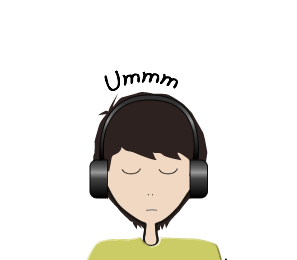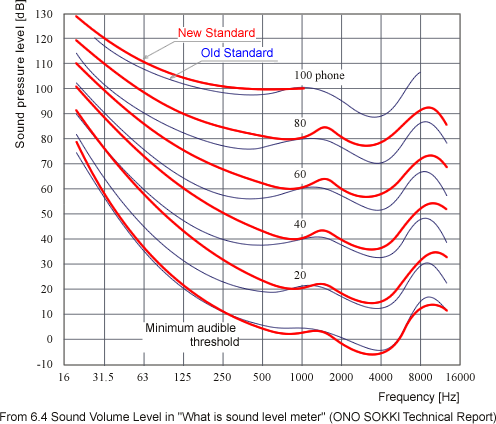- HOME
- Ono Sokki's Patio
- Volume of Sound

Volume of Sound
Ken: I found something interesting.
Dad: I noticed you were turning the volume of the TV up and down. Is it about that?
Ken: Yes. With my headphones on, when I gradually increase the volume, the high pitch sound doesn't change much, but the low pitch sound was easier to hear; and on the contrary, the low sound was harder to hear with lower volume. I first thought it was a problem with the headphones, so I tried it with the TV but it was the same.
Dad: You realized something interesting. The feeling you got when the sound volume changed is the right sense of feeling.
Ken: I thought so. Louder the sound, you hear the low pitch sound more.
Dad: Remember we talked about the "noise level*1" before?
Ken: Somewhat. People's sense of sound volume differs with frequency and the noise level value is obtained after correcting that difference.
Dad: Yes. I only explained it at that level before, so I will explain it in details today. As you mentioned, human's auditory sense hear a different volume depending on the frequency although the sound pressure is the same.
Ken: People are dull to low pitch sound. That means, it has to be at a greater volume or you won't be able to hear it at the same loudness as the high-pitch sound. 
Dad: Yes. Look at the graph here (right graph). This is an equal loudness contour of a pure tone, which is a frequency characteristic of sound pressure where you hear different frequency as the equal loudness, tied in a line.
Ken: There are red and blue lines. Do I just look at the red lines?
Dad: Yes. After a great experiment couple years ago, the standard changed reflecting the result. Using the 1000 Hz sound as a standard, for example, if you look at the 40 phon line*2, the sound pressure of 1000 Hz is 40 dB, but you can tell it's 60 dB for 125 Hz, and 73 dB for 63 Hz.
Ken: That means in order to hear the same volume of 40 dB of 1000 Hz, at 125 Hz you would need a sound pressure 20 dB higher, and at 63 Hz you would need 33 dB higher sound pressure.
Dad: Yes. But the point you realized is the fact the balance of high and low sound changed when the sound volume changed.
Ken: Yes. So in this graph I have to compare the 40 phon line and, let's say, the 80 phon line.
Dad: On the 80 phon line, sound pressure of 1000 Hz is 80 dB, and 125 Hz is 90 dB. There is a difference of 10 dB. On the 40 phon line, the difference between 1000 Hz and 125 Hz is 20 dB. So there is a difference of 10 dB between the above sounds?
Ken: On the contrary, when the sound has a frequency higher than 1000 Hz, the difference of frequencies has less impact on the volume of the sound. This is why I felt low range sound become louder when I turned the volume up. Correct?
Dad: Yes. Going back to the "noise level" correction, the one called "A-weighting" has long been used since 1930's.*3 This frequency weighting, thinking 40 dB as the most probable noise level on a daily base, uses the characteristics almost the same as the inverse of 40 phon equal loudness contour of pure tone to harmonize the instrument-measured sound level with the human audibility to establish the noise evaluation value.
Ken: It's been used for that long?
Dad: Yes. You can say that it is an outstanding evaluation value. It is a magnificent that the complicated sense of sound volume of human can be expressed in a numerical value.
Ken: But as the 40 dB sound is the standard, you may feel a gap between the measured value and the loudness you felt for any noise, louder or quieter than that.
Dad: Exactly. Not just that but for sound volume, masking effect that we talked about before is related as well.
Ken: Yes. I would like to hear about that in detail another time.
*1: Noise level: A-weighted sound pressure level
*2: phon (unit of loudness level) -- The sound pressure level of 1 kHz reference tone which, by listeners with normal hearing ability, is perceived to be equally loud as the sound being measured.
*3: The frequency characteristics of A-weighting was defined based on the 40 phon equal loudness contour of pure tone from the work by Fretcher and Munson of Bell Laboratories in the U.S; it has not changed since then.
- © ONO SOKKI CO., LTD. 1996-2025
